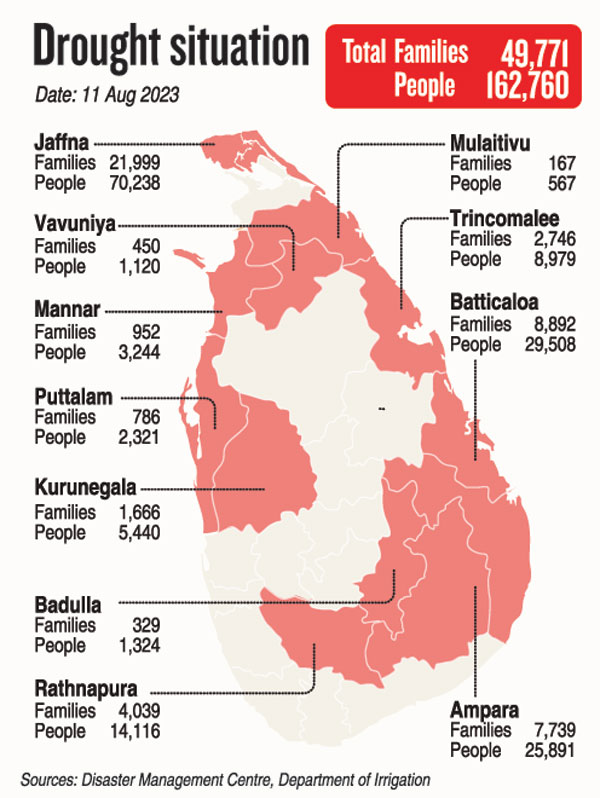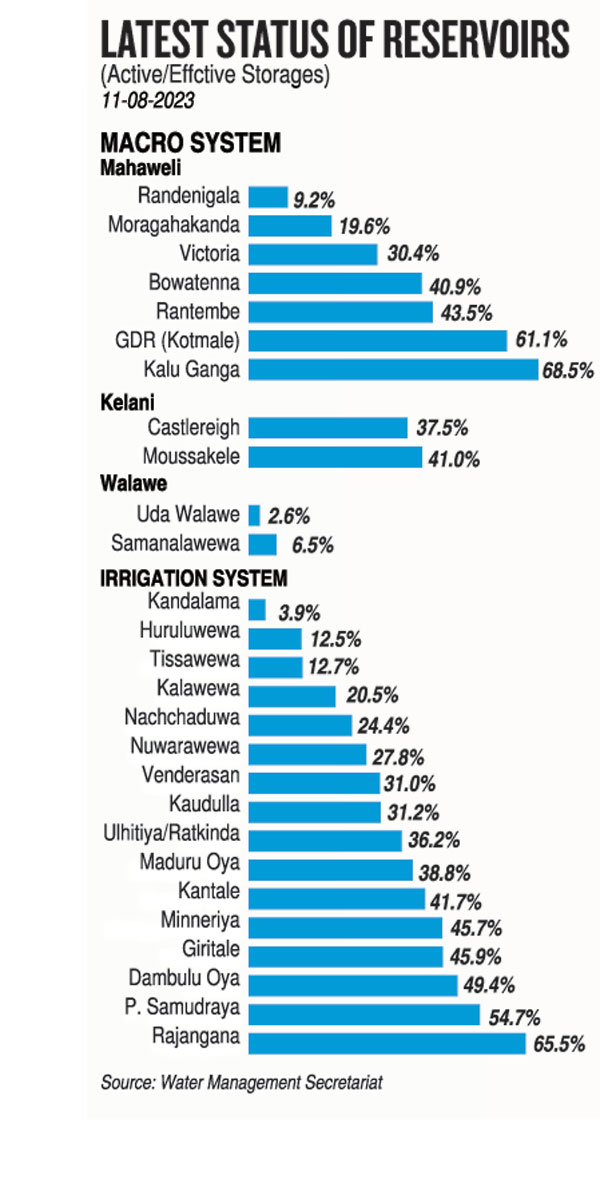News
Southern farmers’ drought woes highlight need for proper water management
View(s):- Agriculture Ministry conducts survey on losses suffered by farmers
- Power minister says Samanalawewa water is mainly for power generation
- Expert recommends inclusion of power sector stakeholders in farmers’ meetings
By Sandun Jayawardana
The extent of the damage to crops in the Walawa region and elsewhere in the country due to the drought is still being assessed, Agriculture Minister Mahinda Amaraweera told the Sunday Times. Minister Amaraweera could not give a timeframe as to when the assessment will be completed. Some 25,000 hectares of paddy lands and 8000 hectares of supplementary crops in the Walawa region alone were at risk from destruction if water was not released from the Samanalawewa reservoir, Irrigation Minister Roshan Ranasinghe told the media last week.
As per the Cabinet decision on Monday, the authorities on Tuesday around 3 am began releasing water from the Samanalawewa reservoir to the Udawalawa reservoir for agricultural purposes. A daily release of 3.5 million cubic metres (MCM) of water was authorised for August 8-10, followed by 2.5 million MCM a day from August 11 to 15 while also generating the maximum amount of hydropower possible, Power and Energy Minister Kanchana Wijesekara said on Twitter.
The Samanalawewa reservoir will be shut down for power generation from August 16 to preserve the dead storage of water in the dam. The Cabinet also approved a proposal to continue an uninterrupted power supply islandwide in spite of the closure of the Samanalawewa power plant on August 16, Minister Wijesekara stated. As such, the government has ruled out imposing power cuts in the Southern region.
Water from the Samanalawewa reservoir is exclusively used for power generation. The severe drought that has been experienced over the past several months however, meant calls grew for water from the reservoir to be released to the Udawalawa reservoir, which supplies water for agricultural purposes. Its water levels had dipped to as low as 1.7% last week. A group of farmers began a Sathyagraha on July 24, demanding that water from the Samanalawewa reservoir be released to Udawalawa.
Initially, however, the Cabinet was reluctant to issue water from Samanalawewa to Udawalawa due to the possibility that it might necessitate a power cut to the Southern Province lasting for about three hours after the plant is shut down. Irrigation Minister Ranasinghe and Agriculture Minister Amaraweera were vocal over the need to release the maximum amount of water for farmers, but the Cabinet sided collectively with Power and Energy Minister Wijesekara.
Amid pictures and visuals of dead and dying paddy crops, however, pressure grew on the Cabinet to rethink its decision, which led to it authorising the release of the water this week.
The water, however, will take time to reach cultivations further downstream and will come too late to save some of those crops, the authorities have conceded. “I believe we can still save the majority of the cultivations but the damage will be most severe on cultivations downstream, some of which are yet to receive the water,” Minister Amaraweera said on Friday.
Farmers’ organisations, meanwhile, are demanding that the Government provide fair compensation for farmers whose suffered losses due to lack of water.
The Sathyagraha organised by farmers demanding water from the Samanalawewa reservoir be released to Udawalawa ended this week after 18 days.
“Farmers started the Sathyagraha on July 24. If the authorities took this decision three weeks ago, we could have further minimised the crop damage,” said Namal Karunaratne, National Organiser of the All Island Farmers’ Federation.
He commended the Human Rights Commission of Sri Lanka for urgently taking up the complaint filed by farmers over the water issue and for instructing the authorities to provide fair compensation to affected farmers. He said farmers were also preparing to go to the Supreme Court over their fundamental rights being violated by the failure to release water to their crops.
The Department of Agriculture publishes a crop forecast on the 15th of every month. The July report, which was before the crisis reached a critical stage, forecasts that this year’s paddy harvest will be sufficient to meet the country’s needs.
“We have to wait for this month’s report to see the full extent of the damage,” said Prof. Buddhi Marambe, Senior Professor in Crop Science at the Faculty of Agriculture, University of Peradeniya. Judging by the visuals and the photographs from the ground, Prof. Marambe said it seems to him that about 20-40% of the crops will recover while 60-80% may recover, “but not fully.”
He pointed out that there are seasonal meetings (‘kanna resweem’) before each cultivation season where all stakeholders including government agencies and farmer associations come together to take decisions with regard to cultivation.
Unfortunately, most decisions taken at these meetings are not properly implemented, said Prof. Marambe. The matter regarding the Samanalawewa reservoir has also shown that there are other stakeholders, such as the CEB, that should also be part of these discussions in certain cases, he pointed out. “We have learnt a bitter lesson from this. Integrated planning is a must. All those who use the water must be part of the discussions,” he stressed.
Prof. Marambe noted that farmers too should be persuaded to start preparing their lands for cultivation with the onset of rains. They should not wait until reservoirs release water. The Agriculture Department has been trying hard to convince farmers on this matter but has not met with much success, he observed. Nevertheless, if the country is to meet the challenge posed by El Nino, farmers need to start preparing their lands for cultivation with the onset of the second inter-monsoon in October, he added.
El Nino is a climate pattern referring to the unusual warming of surface waters in the eastern Pacific Ocean. La Nina, which is the opposite of El Nino, refers to the cooling of surface waters. The phenomenon is referred collectively as the El-Nino Southern Oscillation Cycle (ENSO). The phenomenon can significantly impact global weather.

| Met Dept studies El Nino effect, says rains likely from mid-October Based on global data and data from previous years when Sri Lanka had been affected by the El Nino weather pattern, the Met Department expects an increase in rainfall with the onset of the second inter-monsoon season from mid-October to mid-December, Director General Athula Karunanayake told the Sunday Times. The rains, however, are expected to decrease again from the end of December to April. He noted that the El Nino effect had resulted in less rainfall than normal this year to the central hills, which was why water levels of many reservoirs have dropped significantly. Mr. Karunanayake defended the Met Department from criticism that it had failed to properly alert the authorities about the severity of the dry weather brought conditions on by the El Nino phenomenon. Before the onset of the monsoon, the Met Department holds an annual “Monsoon Forum” which brings together all stakeholders including the Departments of Agriculture, Irrigation, the Water Board and the CEB. This year’s forum was held in April with the participation of some 28 stakeholders. “We gave a seasonal forecast and said then that the El Nino situation will affect rainfall. Unfortunately, it seems to us that there are shortcomings in the mechanism whereby this was relayed to the grassroots level,” he said.
| |
 The ground reality in drought-hit Vavuniya. Pic Romesh Madusanka Drinking water scarcity hits 163,000 people in 11 districts; DMC deploys bowsers More than 163,000 people in 11 districts are now affected by drinking water scarcity due to the prevailing dry weather conditions, according to the latest statistics by the Disaster Management Centre (DMC). There is no difficulty for the DMC to provide drinking water to the affected persons, though the number of affected is slightly higher than during this time in previous years, the DMC’s Director General Maj. Gen. (Retd.) S. Ranasinghe said. The centre has deployed 191 tractor bowsers, 43 lorry bowsers and 90 newly acquired Chinese-built bowsers with a capacity of 27,000 litres to provide drinking water to the affected people. They are deployed at 196 locations in the country’s 25 districts, said the DG. |

The best way to say that you found the home of your dreams is by finding it on Hitad.lk. We have listings for apartments for sale or rent in Sri Lanka, no matter what locale you're looking for! Whether you live in Colombo, Galle, Kandy, Matara, Jaffna and more - we've got them all!

